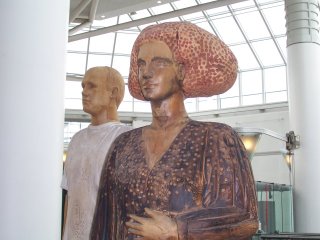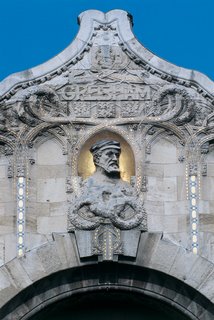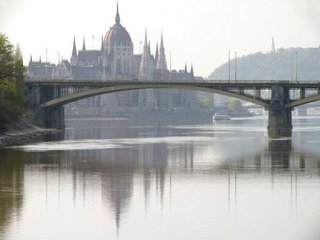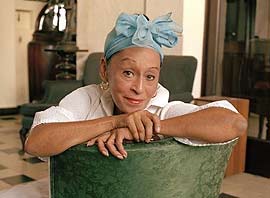 Il Terzo CerchioDivine dishes in a genuine Italian setting make this cellar bar a hidden treat.
Il Terzo CerchioDivine dishes in a genuine Italian setting make this cellar bar a hidden treat.A FourBees review
Il Terzo Cerchio, possibly my favourite Pest Italian restaurant (my Buda favourite being the atmospheric Piazza Italia) used to have an incongruously Spanish name Puerto Escondido translating as “hidden doorway” and taken from a film about safecrackers in Lisbon. However it was rather appropriate considering this tesoro escondido was the Pest Italian community’s hidden treasure and best-kept secret.
I’d enjoyed many a steaming bowl of spaghetti deep in the bowels of Nagydiófa utca (opposite the Uránia National Film Theater on Rákóczi út). Now, after extensive renovation and enlargement, the same ownership have reopened under the new name of Il Terzo Cerchio, referring to a part of Canto VI of Dante Alighieri’s Inferno. This is the “third circle” of upper hell, where those who committed the sin of gluttony end up.
I have seen numerous restaurants in Italy called Il Terzo Cerchio. It must be either a warning, or somehow a comfort, that all of us who adore Italian cuisine are going to end up in the “third circle” - at least we’ll all be together and enjoying a good nosh.
The basement venue just oozes la bella Italia. We passed through the empty ground floor; it used to be an ice cream selling venue (and maybe will again come summer), then descended into Il Inferno, another misnomer for this was a well-ventilated, cool and airy cellar space.
Past the bar and kitchen, the first room is darker and romantic but we turned left and found ourselves slap bang in the heart of Italy.
In this second room, the lights were on, the television was blaring and a collection of guests, all Italian, sat dotted about the cluster of tables all gazing at the news program. The noise, or that which could be heard above the TV was all in Italian; “Sergio, come stai?” “Giacomo, va bene” or “Ma figurati, Angelo” echoed through the cellar rooms bouncing off the walls which have been covered with crazy paving stone tiles up to shoulder height.
Il Terzo Cerchio is decorated extremely simply and unassumingly, but given the clientele, they don’t need carafes of Chanti or blown-up shots of Taormina or the Venetian skyline to waft visitors immediately to the country of pizza, pastasciutta and zabaglione.
Having discovered recently that a branch of my family is descended from Giuseppe Garibaldi (the picture above shows what a handsome chappie he was, and so serious!) - the revolutionary, not the squashed fly biscuit, I hasten to add - I have been enthusiastically rediscovering my Italian roots. On a trip to Naples, this cultural rebirth took the form of sampling every possible pastasciutta, pizza and zabaglione available, and thus I now consider myself somewhat of a connoisseuse, if not a grossly overweight Italian mama.
If the omnipresent Italian chef and community doesn’t convince you, the waitress Zsuzsa gabbles away with gusto in a fluent mix of Italian and Hungarian. In fact, I can’t report on the exact price of the dishes as she rattled off about 15 possible choices - all equally tempting involving spicy sausage, tomato sauces and “long or short pasta” - before I had time to draw breathe, let alone jot it all down.
Suffice to say, my trencherwoman companion adored the bruschetti (about 1,000 forints): toast with a selection of tomato, mushrooms, Cannellini beans or chicken livers to add yourself, then wolfed down a gigantic slice of chicken breast (about 2,000 forints), perfectly char-grilled with cheese and wafery prosciutto, served with oven-baked potatoes.
I devoured my “vitamin-bomba” - a gigantic insalatone (1,100 forints) with a generous assortment of iceberg lettuce, carrot, black and green olives, tomatoes and chunks of bland white cheese.
I followed this with a spaghetti Amalfi (450 forints) which was laden with juicy tinned tomatoes, olive oil and olives and I dipped into the fresh parmesan at regular intervals, throwing caution and gall bladder twinges to the wind.
I felt like the general in the film Babette's Feast who, on attending a special meal in the Puritan religious colony in northern Jutland, recognizes special delicacies from his days in Paris and goes into private paroxysms of pleasure with each mouthful. Ooh, real Parmesan, aah fresh tomatoes, I oozed discreetly to myself.
The menu offers all kinds of pasta with delicious sauces, pizzas baked in a proper oven, meat and fish and desserts such as Tiramisú.
We both sampled the house wine (from Hungary) and gawped as the comedian/actor/director Leonardo Pieraccioni entertained the room on a cable channel. I was so carried away by the ambiance, that I was a little disappointed to leave Il Terzo Cerchio and discover I was on a chilly back street on a dark January night and not some elegant Campanian terrace looking out over the bay of Naples as the sun set behind Vesuvius.
So much for my fantasies. Queen Bee has studied the picture of the great Giuseppe Garibaldi (shown above) for several minutes and he does indeed bear a striking resemblance to my second cousin, Patrick, the very man who is researching into the family line and descendants via a certain Anna Paggi.
If any of you little bees out there in cyber land can help with this mystery, please give me a buzz!
II Terzo Cerchio
Budapest - Distrct VII
Nagydiófa utca 3
Getting there: Bus 7, 78 to Vas utca/metro 2 (red line) to Blaha Lujza térTel: (+36 1) 352-8669 Open daily noon-midnight
THE STINGDécor 6/10
Cuisine 8/10
Service 8/10
Wine List 7/10
Ambience 9/10
The Bees' Knees 8/10



























